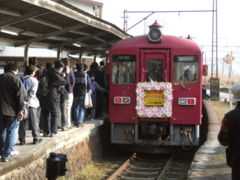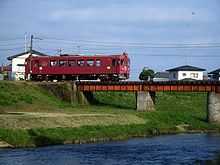Kurihara Den'en Railway Line
| Kurihara Den'en Railway Line | |||||||||||||||||||||||||||||||||||||||||||||||||||||||||||||||||||||||||||||||||||||||||||||||||||||||
|---|---|---|---|---|---|---|---|---|---|---|---|---|---|---|---|---|---|---|---|---|---|---|---|---|---|---|---|---|---|---|---|---|---|---|---|---|---|---|---|---|---|---|---|---|---|---|---|---|---|---|---|---|---|---|---|---|---|---|---|---|---|---|---|---|---|---|---|---|---|---|---|---|---|---|---|---|---|---|---|---|---|---|---|---|---|---|---|---|---|---|---|---|---|---|---|---|---|---|---|---|---|---|---|
 Near Hosokura Mine Park Mae in 2006 | |||||||||||||||||||||||||||||||||||||||||||||||||||||||||||||||||||||||||||||||||||||||||||||||||||||||
| Line length: | 25.7 km (16.0 mi) | ||||||||||||||||||||||||||||||||||||||||||||||||||||||||||||||||||||||||||||||||||||||||||||||||||||||
| Track gauge: | 1,067 mm (3 ft 6 in) | ||||||||||||||||||||||||||||||||||||||||||||||||||||||||||||||||||||||||||||||||||||||||||||||||||||||
Legend
| |||||||||||||||||||||||||||||||||||||||||||||||||||||||||||||||||||||||||||||||||||||||||||||||||||||||
The Kurihara Den'en Railway Line (くりはら田園鉄道線 Kurihara Den'en Tetsudō sen) was a rural rail line in Miyagi Prefecture, Japan, abandoned on March 31, 2007. Running from Ishikoshi Station in Tome, Miyagi with a connection to the Tōhoku Main Line, extending westward to inland Hosokura Mine Park Mae Station in Kurihara, along central Kurihara. This line used to be called for short Kuriden (栗電 or くりでん) because the preceding name of the operator was the Kurihara Electric Railway (栗原電鉄 Kurihara Dentetsu).
The line was initially constructed for ore of Hosokura Mine (細倉鉱山 Hosokura Kōzan) at the end of the line which was closed in 1988.
Description
As of 2007
- Distance: 25.7 km
- Rail gauge: 1,067 mm (3 ft 6 in)
- Stations: 16
- Track: Single
- Power: Internal combustion (Diesel)
- Block System:
- Staff Block (Ishikoshi - Wakayanagi, Kurikoma - Hosokura Mine Park Mae)
- Tablet Block (Wakayanagi - Kurikoma)
Infrastructure
The operator introduced diesel multiple units (DMU) on the reorganization in 1995, but the old 750V DC electric installation remained for economic reasons. It was one of few railways then in Japan that operated with an obsolete semaphore signal system and non-automatic blocking system.
Operation and service
All trains consisted of a single car without a conductor. The fare was twice as high as comparable distances on Japan Railways lines. Only three of the sixteen stations, namely Wakayanagi, Sawabe, Kurikoma were regularly staffed.
History
Originally the line was 762 mm (2 ft 6 in) gauged, constructed by Kurihara Tramway (栗原軌道 Kurihara Kidō) and opened in 1921, later renamed to Kurihara Railway (栗原鉄道 Kurihara Tetsudō) in 1941 and again to Kurihara Dentetsu in 1955.
The closure of Hosokura Mine in 1988 reduced freight traffic. The company had hoped for tourists to the Hosokura Mine Park, an amusement park built at the mine site. But this effort failed to stop the decrease of passengers. Municipalities decided to retain the operator as a third sector (in Japanese sense) in 1993, renamed on April 1, 1995 to Kurihara Den'en Railway.
The company has curtailed investment and maintenance measures and made some efforts to increase passengers. But the rapid shift to car traffic has overwhelmed railways everywhere in Japan since the 1990s. Miyagi Prefecture had subsidized the deficit for several years, but in 2001 gave notice to the municipalities of a future suspension of the subsidy. In December 2003 they decided to close the railway in March 2007.
Timeline

- December 15, 1918: Kurihara Tramway (栗原軌道 Kurihara Kidō) established
- December 20, 1921: Ishikoshi - Sawabe (8.85 km)
- December 17, 1922: Sawabe - Iwasasaki (later Kurikoma) (7.73 km)
- December 3, 1941: Classification from tramway to railway, renamed to Kurihara Railway (栗原鉄道 Kurihara Tetsudō)
- December 1, 1942: Iwasasaki - Hosokura Mine (ca. 9.62 km), 26.2 km stretch completed
- September 21, 1952: Electrified DC 750V
- September 26, 1955: Regauged from 762 mm (2 ft 6 in) to 1,067 mm (3 ft 6 in) for through operation to the then Japanese National Railways
- November 29, 1955: Renamed to Kurihara Electric Railway (栗原電鉄 Kurihara Dentetsu)
- June 1, 1964: Bus and train services in the area combined to a single company, Miyagi Chūō Kōtsū (宮城中央交通)
- August 31, 1968: Bus service separated to Miyagi Central Bus (宮城中央バス Miyagi Chūō Bus)
- February 25, 1969: Renamed back again to Kurihara Electric Railway
- March 29, 1987: Hosokuura - Hosokuura Mine freight service closed
- November 1, 1988: Hosokuura - Hosokura Mine (0.8 km) abandoned (in some source on October 27)
- June 16, 1990: Hosokura - Hosokura Mine Park Mae (0.2 km) opened. Hosokura Station abandoned
- December 15, 1993: Mitsubishi Material transferred ownership of the Kurihara Electric Railway to the then five towns (in 2007, 2 cities) along the line
- May 1, 1995: Renamed to Kurihara Den'en Railway. Electric operation terminated. Conductorless operation introduced
- April 1, 2007: Railway service abandoned
Stations
As of 2007. All stations were in Miyagi Prefecture.
- Ishikoshi 石越
- In Tome
- Aramachi 荒町
- Wakayanagi 若柳
- Yachihata 谷地畑
- Ōokashōmae 大岡小前
- Ōoka 大岡
- Sawabe 沢辺
- Tsukumo 津久毛
- Sugihashi 杉橋
- Toyasaki 鳥矢崎
- Kurikoma 栗駒
- Kurihara Tamachi 栗原田町
- Omatsu 尾松
- Uguisuzawa 鶯沢
- Uguisuzawa Kōgyōkōkō Mae 鶯沢工業高校前
- Hosokura Mine Park Mae 細倉マインパーク前
- In Kurihara
Rolling stock

| Wikimedia Commons has media related to Kurihara Denen Railway. |
- For service
- KD 95 type
- Railcar (DMU) built in 1995. Nos. KD 951 to KD 953
- KD 10 type
- Railcar (DMU) for busy hours, used with conductor. Nos. KD 11, KD 12, previously Nagoya Railroad "Kiha 10" type, nos. "Kiha 15", "Kiha 16"
- For maintenance
- DB 10 type
- Diesel locomotive, 4-wheel. No. DB 101
- MC 100 type
- Motor car
- No. "To 102", "To 103"
- Wooden truck (gondola)
- No. "Wafu 74"
- Wooden wagon
- Preserved from electrified period, at Kurihara Mine Park Mae
- ED202
- Electric locomotive, 2-truck, 8-wheel. Regauged survivour of 762 mm (2 ft 6 in) era
- No. "Wa 71"
- Wooden wagon
- Left intact in Wakayanagi depot
- EMUs used until 1995
- M15 type, newly built on regaugement, etc.